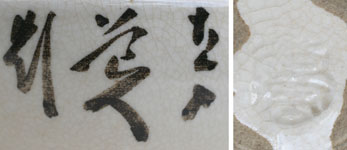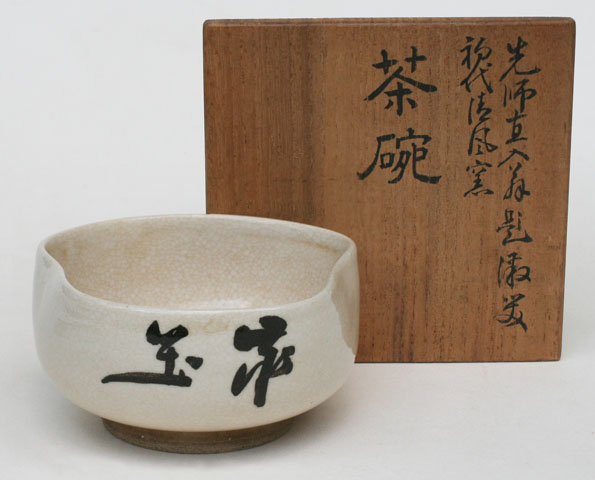Chanoyu
Natsu chawan, summer tea bowl - bishô, smileSigned: Kyujûsan ô (93) Chokunyû Dôjin chi
Seals: Seifu
Technique: Wheel-turned and handshaped cream crackled glazed Kyoyaki with a black tetsu-e underglaze calligraphy Ø 11 x 5,4
Date: 1906
Box: authorized by Tansui Gyojin, a member of a younger Seifu generation
Condition: fine
微笑- bishô, smile
Mitsumiya Chokunyû was born in Takeda, Ôita prefecture in Bungo province. He was the third son of the Oka han clansman Mitsumiya Denuemon. In 1820 he studied Kano painting with Okamoto Baisetsu. Two years later introduced Watanabe Hôtô (1752?-1833), uncle of Chokunyû and the teacher of Tanomura Chikuden Chokunyû to Chikuden and entered his school. Chikuden recognized his talents and adopted him into the Tanomura family.
Chokunyu accompanied his teacher on his many trips
During the trip in 1834 he accompanies Chikuden to Osaka and enters Senshindô, the school of Oshio Chûsai (1792-1837) to learn yomeigaku (Neo-Confucianism) and meets Fujisawa Tôgai (1794-1864), Shinozaki Shôchiku (1781-1851), Gotô Shôin (1797-1864), and Okada Hankô (1782-1846). He also receives a certificate for the Satake riryu style of Sojutsu (using the spear in martial arts). After Chikuden’s death he returns to Oita for four years, but feeling isolated brings him back to Kansai. At the age of 27 he settles at Sakai near Osaka, where he opens a school and a poetry group called the “Kôsaiginsha”, which had about 300 members.
From his youth Chokunyû studied Zen. When he was 35 years old he was invited at the Manpukuji, the Ôbaku Zen temple to receive Zen training. He managed to get his inka, certificate of enlightenment, and in 1899 he became head priest at the Shishirin-in subtemple.
He moves to Kôraibashi, Osaka in 1860, where in 1862 he commemorated the hundredth anniversary of the founder of sencha, tea master Basaô (1672-1763), with a large tea ceremony and the display of tea ceremony related artwork on the Seiwan banks of the Yodo river known as the “Seiwan Chakai”. Chokunyû was a great promotor of the Sencha and organized a number of these gatherings with seki, tea serving environments displayed with important works of art. He documented a number of the chakai in books and handscrolls.
In 1868 Chokunyû moved to Kyoto. Ten years later he was asked to establish the Kyoto prefectural Painting School. After he raised the funds and the Maruyama-Shijô Painters, Kôno Bairei (1844-1895), Mochizuki Gyokusen (1852-1906), Kubota Beisen (1852-1906) and Kose Shôseki (1843-1919) the school was in existence in 1880 and Chokunyû its first director. Two years later he opened a private school Nanshû Gagakko to teach Nanga painting, which merged in 1896 with the Nihon Nanga Kyôkai, Japan Nanga Association newly established together with Tomioka Tessai (1837-1924), and Taniguchi Aizan (1816-1899).
In 1884 he resigned from his position due to the rivalry between the representatives of the distinct painting styles.
Reference:
Roberts p. 174
Araki pp. 1080-1081
Graham p. 171 ff.
Berry & Morioka ‘99 p. 92-95
Berry & Morioka ‘08 p. 303-05
Seifu Yohei III was the son of the Maruyama-school painter Okada Ryohei. He studied painting at the age of thirteen with Tanomura Chokunyû and pottery with Seifu Yohei II. He took over the Seifu workshop in 1872 and adopted the name Seifu III in 1878 after the death of his teacher. Building on family tradition he attempted to achieve complete mastery in the combination of ceramics and painting. He made great efforts to improve the quality of Kyoto wares. Seifu, unlike many potters of the time, was low production and tenacious in approach.He was a founding member of the potters’ associations of Awata and Kiyomizu Gojôzaka and of the Kyoto Ceramic Research Institute. Working in a Sino-Japanese style, he produced mainly for the domestic market and received many awards in Japan. In 1893 Seifu became the first ceramist to be admitted to the Teishitsu Gigei-in and in 1895 he was made a member of the Order of the Green Ribbon.
Price: ON REQUEST

